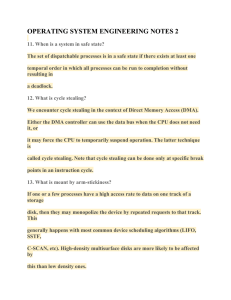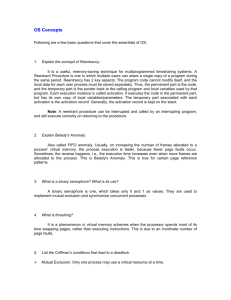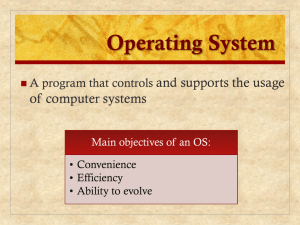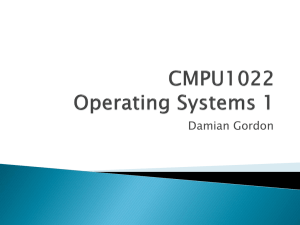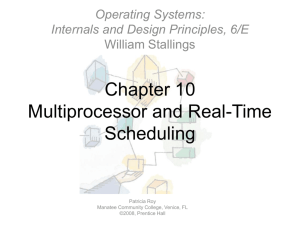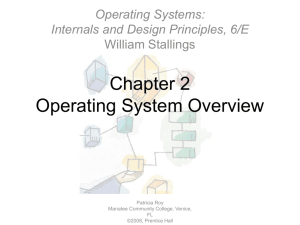chapter10 - Website Staff UI
advertisement
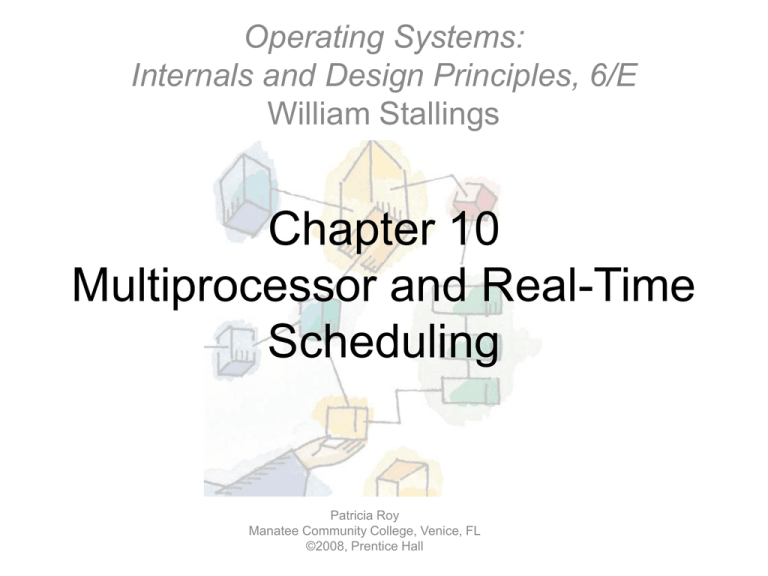
Operating Systems: Internals and Design Principles, 6/E William Stallings Chapter 10 Multiprocessor and Real-Time Scheduling Patricia Roy Manatee Community College, Venice, FL ©2008, Prentice Hall Classifications of Multiprocessor Systems • Loosely coupled or distributed multiprocessor, or cluster – Each processor has its own memory and I/O channels • Functionally specialized processors – Such as I/O processor – Controlled by a master processor • Tightly coupled multiprocessing – Processors share main memory – Controlled by operating system Parallelism Granularity • Independent – Separate application or job – No synchronization among processes – Example is time-sharing system • Coarse and Very Coarse-Grained Parallelism – Synchronization among processes at a very gross level – Good for concurrent processes on a multiprogrammed uniprocessor – Can by supported on a multiprocessor with little change • Medium-Grained Parallelism – Single application is a collection of threads – Threads usually interact frequently • Fine-Grained Parallelism – Highly parallel applications – Specialized and fragmented area Scheduling Design Issues 1. Assignment of processes to processors 2. Use of multiprogramming on individual processors 3. Actual dispatching of a process Assignment of Processes to Processors • Treat processors as a pooled resource and assign process to processors on demand • Permanently assign process to a processor – Known as group or gang scheduling – Dedicate short-term queue for each processor – Less overhead – Processor could be idle while another processor has a backlog Assignment of Processes to Processors • Global queue – Schedule to any available processor P1 P2 QUEUE P3 P4 Assignment of Processes to Processors • Master/slave architecture – Key kernel functions always run on a particular processor – Master is responsible for scheduling – Slave sends service request to the master – Disadvantages • Failure of master brings down whole system • Master can become a performance bottleneck Assignment of Processes to Processors • Peer architecture – Kernel can execute on any processor – Each processor does self-scheduling – Complicates the operating system • Make sure two processors do not choose the same process • Make sure there a no processes lost in queue • Resolve & synchronize resources’ competition Synchronization Granularity and Processes Multiprogramming on Individual Processors • Utilization vs Better Performance • Best Performance when threads are able to run simultaneously Processs scheduling in multiprocessor: – Is feedback prioritization effective? – Or FCFS with less overhead? Process Dispatch: Process Scheduling • Single queue for all processes • Multiple queues are used for priorities • All queues feed to the common pool of processors Comparison One and Two Processors Comparison One and Two Processors Thread Scheduling • Execution is separated from the rest of the process • An application can be a set of threads that cooperate and execute concurrently in the same address space • Performance = F( degree of paralellism, thread management and scheduling) Multiprocessor Thread Scheduling • Load sharing – Processes are not assigned to a particular processor • Gang scheduling – A set of related threads is scheduled to run on a set of processors at the same time • Dedicated processor assignment – Threads are assigned to a specific processor • Dynamic scheduling – Number of threads can be altered during course of execution Load Sharing • Load is distributed evenly across the processors • No centralized scheduler required • Use global queues including priority-based and feedback schemes • Versions of Load sharing: – FCFS – Smallest number of threads first – Preemptive smallest number of thread first Disadvantages of Load Sharing • Central queue needs mutual exclusion • Preemptive threads are unlikely resume execution on the same processor (inefficient cache in processor) • If all threads are in the global queue, all threads of a program will not gain access to the processors at the same time Gang Scheduling • Simultaneous scheduling of threads that make up a single process • Useful for applications where performance severely degrades when any part of the application is not running • Threads often need to synchronize with each other Example Scheduling Groups Dedicated Processor Assignment • When application is scheduled, its threads are assigned to a processor • Some processors may be idle • No multiprogramming of processors – No need since performance & effectiveness does not rely on this issue any more – Skip process switching speedup Application Speedup Dynamic Scheduling • Number of threads in a process are altered dynamically by the application • Operating system adjust the load to improve utilization – Assign idle processors – New arrivals may be assigned to a processor that is used by a job currently using more than one processor – Hold request until processor is available – Assign processor a job in the list that currently has no processors (i.e., to all waiting new arrivals) Real-Time Scheduling • Correctness of the system depends not only on the logical result of the computation but also on the time at which the results are produced • Tasks or processes attempt to control or react to events that take place in the outside world • These events occur in “real time” and tasks must be able to keep up with them Real-Time Systems • • • • • • Control of laboratory experiments Process control in industrial plants Robotics Air traffic control Telecommunications Military command and control systems Characteristics • Determinism – Operations are performed at fixed, predetermined times or within predetermined time intervals – Concerned with how long the operating system delays before acknowledging an interrupt and there is sufficient capacity to handle all the requests within the required time Characteristics • Responsiveness – How long, after acknowledgment, it takes the operating system to service the interrupt – Includes amount of time to begin execution of the interrupt – Includes the amount of time to perform the interrupt – Effect of interrupt nesting Characteristics • User control – User specifies priority – Specify paging – What processes must always reside in main memory – Disks transfer algorithms to use – Rights of processes Characteristics • Reliability – Degradation of performance may have catastrophic consequences • Fail-soft operation – Ability of a system to fail in such a way as to preserve as much capability and data as possible Features of Real-Time OS 1. Fast process or thread switch 2. Small size 3. Ability to respond to external interrupts quickly 4. Multitasking with interprocess communication tools such as semaphores, signals, and events Features of Real-Time OS 5. Use of special sequential files that can accumulate data at a fast rate 6. Preemptive scheduling base on priority 7. Minimization of intervals during which interrupts are disabled 8. Delay tasks for fixed amount of time 9. Special alarms and timeouts Scheduling of Real-Time Process Scheduling of Real-Time Process Scheduling of Real-Time Process Scheduling of Real-Time Process Real-Time Scheduling • Static table-driven – Determines at run time when a task begins execution • Static priority-driven preemptive – Traditional priority-driven scheduler is used • Dynamic planning-based – Feasibility determined at run time • Dynamic best effort – No feasibility analysis is performed – Try to meet deadlines and abort those who missed Deadline Scheduling • Real-time applications are not concerned with speed but with completing tasks • Information used – – – – – – – Ready time Starting deadline Completion deadline Processing time Resource requirements Priority Subtask scheduler Two Tasks A B Deadline period 20 ms 50 ms Processing Time 10 ms 25 ms Scheduling Execution Profile Scheduling Rate Monotonic Scheduling • Assigns priorities to tasks on the basis of their periods • Highest-priority task is the one with the shortest period Task Set Periodic Task Timing Diagram Priority Inversion • Can occur in any priority-based preemptive scheduling scheme • Occurs when circumstances within the system force a higher priority task to wait for a lower priority task Unbounded Priority Inversion • Duration of a priority inversion depends on unpredictable actions of other unrelated tasks Priority Inheritance • Lower-priority task inherits the priority of any higher priority task pending on a resource they share
